Key Lessons Learned
For our key lessons learned, the big one here was really the pricing. The previous generation (Ryzen 9 4900H RZBOX) started at $499 but crept up to $749 when we purchased the unit in February 2022 and then up to $799 by the time our review was live in April 2022.
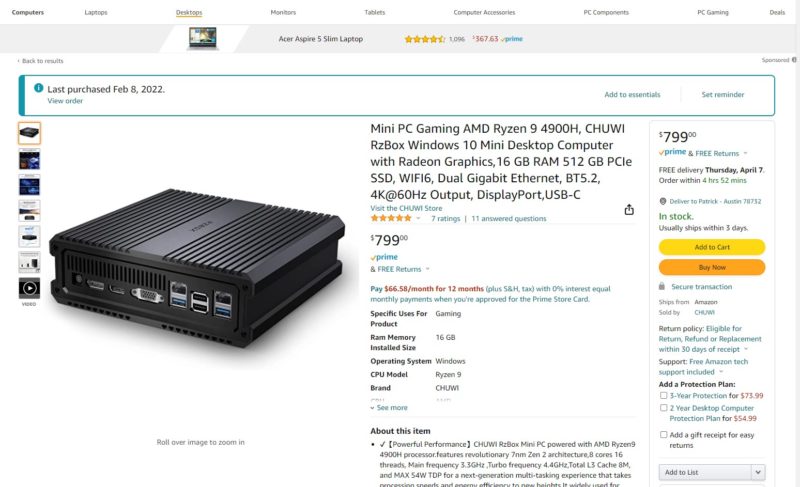
If you saw my Tweet last evening when we did the price check on these, there were two items of note. First, the Amazon pricing is $649 – $85 for $565. That is $185 less than we purchased the previous iteration on Amazon for.
I was looking at Amazon at a box. I went to the video in the listing and thought: Wait, why does this guy look familiar? pic.twitter.com/Bwgni0pUJB
— Patrick J Kennedy (@Patrick1Kennedy) July 8, 2022
The other item we saw was that CHUWI took our previous generation Ryzen 9 4900H RZBOX video, cut ~45% of the video out, then uploaded it for the new system’s assets on Amazon. There was a long pause in the segment that I sent to Alex as I was shocked to see my face while doing the price check. Usually, companies like Dell, HP, and Lenovo would ask permission and seek to license assets we produce for things like this. Standards are different in other places, so I think this exemplifies that one should expect a different experience with CHUWI than the large OEMs better than I can write.
My other key lesson learned was really just that I felt like I wanted more. These still utilized 1GbE NICs and the USB situation was decidedly lower speed than we would have liked to have seen. Since these are second (or third, or tenth) PCs for many of our users, having an easy path to RDP with Windows 11 Pro and other features to manage the fleet are useful. This unit came with Windows 11 Home.
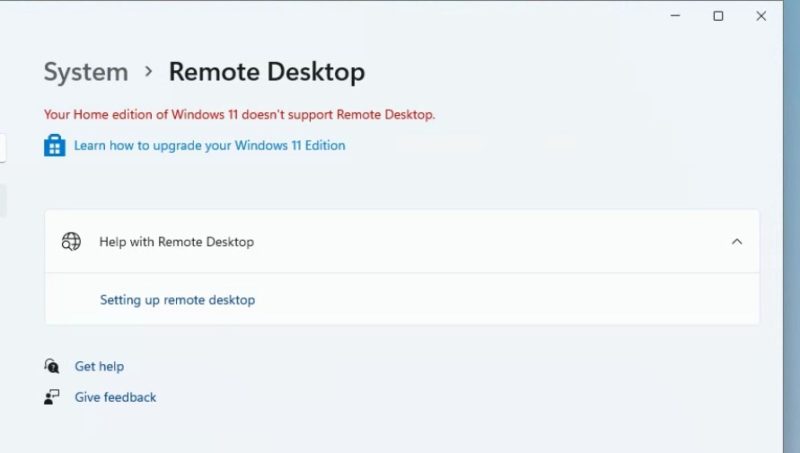
Bringing the price down from what we purchased the previous version it also required single-channel 16GB memory and a slower 512GB SSD. Really the main upgrade was the AMD Ryzen 7 5800H and that is very good.
Here is a link to the current Amazon pricing (affiliate link here), which is lower than the CHUWI direct pricing at the time of writing this.
At $565-$570, this unit is less expensive than many Project TinyMiniMicro nodes even those with less capabilities. It is also less expensive than some of the STH Mini PC’s we have looked at with the Ryzen 9 5900HX. While the pricing feels good, it also feels like this PC with low-cost upgrades (dual 2.5GbE, Windows 11 Pro, a slightly bigger/ better cooler, and better USB 3 support) sold at $599 would be an even better value. At this end of the market, $35 is significant, so that is why those decisions were likely made.
Final Words
This is one of those interesting reviews. It is seemingly the exact same system we reviewed previously with a few minor changes. The AMD Ryzen 7 5800H swap was great for the RZBOX. The swap to single-channel DDR4-2666, a slower SSD, and the AMD-MediaTek NIC saved on cost but were slight system downgrades.
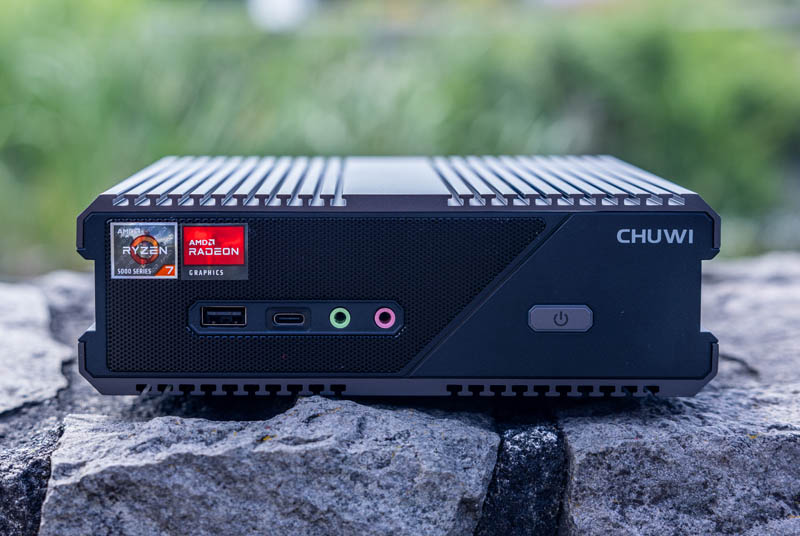
With all of that though, this system is still a fairly decent machine. Adding a second 16GB module yields a fairly affordable machine that performs well. If you are looking for large OEM vendor on-site support, regular(-ish) BIOS updates and so forth, then you will probably pick traditional OEMs over CHUWI. Still, for many, the cost of these units will be too much to pass up.
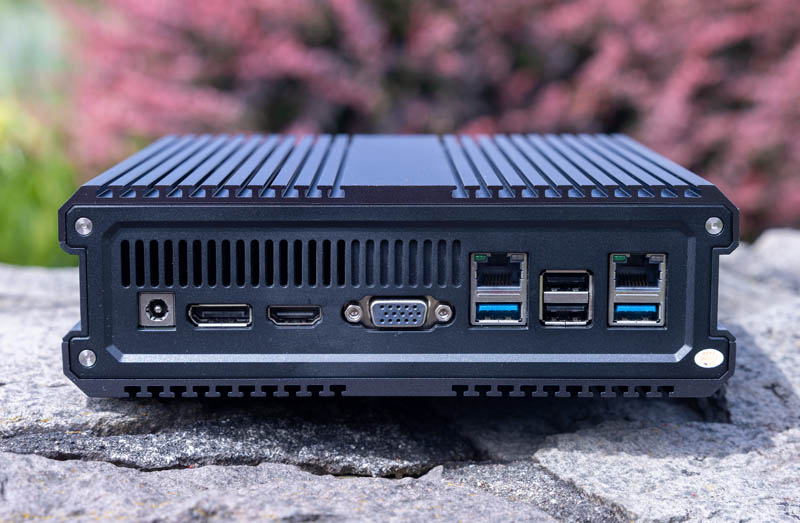
Perhaps the hardest thing to do in this market is to differentiate in the mid-range, and CHUWI has done it. The CHUWI RZBOX AMD Ryzen 7 5800H edition is good, but it is also not perfect. Then again, I am not perfect. The upgrade to the Ryzen 5000 series CHUWI needed to do to stay competitive in the market, and both this and the Ryzen 4000 series versions have been running well for us so far. In our previous RZBOX review, we said the value proposition fit squarely in the “it is complicated” category. With the newest Ryzen 7 5800H iteration, it feels like the CHUWI RZBOX has a much stronger value proposition.

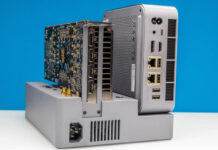


It’d be interesting to see what the idle/avg/max power usage does when changing the BIOS power settings, maybe along with a benchmark or two. Doing a full benchmark run for 6 different BIOS settings is overkill.
Over priced crap. One gets to pay laptop rice for a small board, containing just SoC and connectors with subpar cooling system, witz usually heavilly trimmed I/O options.
Why is so rare to find unit with 4 DP outputs ? SoC certainlo offers it.
Also, one would expect in such a system at least one ( inf not two) 10GbE NICs and at least couple of 2.5GbE ones.
With preferrably rich M.2 and SSD options, serial ports and some GPIO.
This would give it some possible roles where 5800H laptop couldn’t reach and perhaps some justification for the price.
in my opinion is asrock deskmini-serie is still the best option for very small desktop.
you can choose own cpu, memory and storage
No BIOS update is a big no-no.
On the other hand, the BIOS looks like a BIOS instead of the POS Gigabyte puts in their Brix 4800U.
What’s really interesting about this review(and some others of devices of similar provenance) is how they indirectly highlight the amount of engineering that goes into the TMM ~1L corporate-line systems that you’ve also been reviewing:
You don’t really notice it just by reading one of the TMM reviews; because so much of it is what isn’t there: no service access panel that requires 8 screws to remove, no oddly high idle power numbers, no plastic overlays on top of the actually structural parts of the chassis, etc. When there are criticisms of what you can see to be made; it’s normally fairly subtle quality-of-life stuff like Dell’s fixed SATA connector being nicer than the ones based on a proprietary adapter cable; but Lenovo’s tendency to expose both RAM and M.2 on the bottom panel, no need to pull the CPU cooler, being a virtue in non-SATA scenarios; but it’s all (comparatively) minor stuff against a background of exhaustively honed designs.
There are deficiencies and virtues that are immediately clear; but it’s having reviews from totally different worlds of products that really drives home the ones that are only visible in context.